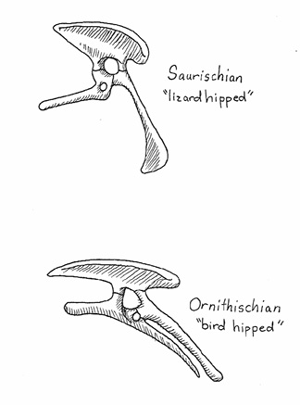Sign up for Lesson Plans, discounts & more!
Dinosaur Classification
It's All in the Hips
Dinosaur classification takes alot of things into account.
When most of us think about dinosaurs we conjure up visions of t-rex, triceratops, or the long-necked brachiosaurus. Maybe you think of the dinos with sails or plates on their backs like stegosaurus or spinosaurus. The truth is these famous creatures represent a group of animals who lived on our planet for approximately165 million years and had a diversity of species that equaled the fishes of the Devonian era or the mammals of modern-day.
That’s a lot of species to organize! Of course, there are many ways one
might do that organization, but a simple one that can be easily
understood by young dino-enthusiasts is to group the dinosaurs by their
hip structure. Why look at hips before looking at characteristics like
meat-eating vs plant-eating or two-leg walkers vs four-leg? Because
paleontologists look at bone structure as a starting place for
classification. It may be a little of a "which came first: the chicken
or the egg" thing, but the structure may be dependent on the behaviors
or the behaviors may be a result of the structure. Regardless, it is
just one place to start on our journey of organizing these diverse
creatures, so let’s begin.
Most dinosaurs had one of two types of hip structures: the bird-hipped or the lizard-hipped.
The hip structure allowed the dinos to move in certain ways and
supported the type of eating it did. It could be that the hips were the
start of it all. Scientists noticed this and decided that this characteristic should be the number one consideration for dinosaur classification.
Bird-hipped dinos are known as the ornithischians. The first part of the word ornithiscians, Ornith, is a prefix that comes from Greek and Latin roots meaning "bird." You may have heard words like ornithology (the study of birds) or ornithopter (a machine that flies using a flapping wing motion, like that of a bird.) Both those words come from ornith meaning bird.
The main part of the word is ischians, a Greek root meaning "hip joint." So the term is pretty logical: "bird hip joint" or "bird-hipped."
What's more important is the structure of the bird-hipped dinos. The shape resembles that of modern bird hip structures, but it doesn’t necessarily mean that birds came from dinos…that’s another discussion. When one looks at the structure of the bird-hipped dinos, you see the pubic bone points backwards and the ichium extends back almost horizontally. The illium bone that sits at the top of the hip tends to be elongated and narrow. All of this allowed lots of space for the large intestines, an important feature for plant-eaters who needed that space for the complex digestion of their food. But be careful, all ornithischians were not plant eaters, nor were all lizard-hipped dinos meat–eaters.
The lizard-hipped dinos are called saurischians. The ischian part is the same as the ornithischians: hip joint. The prefix saur comes from the Greek saur meaning "lizard."
The saurischians had a pubic bone that pointed forward between their legs. This gave them strength and support for fast running. These dinos were mostly meat-eaters so they had to get around quickly to catch their prey. The illium at the top of the hip was broad and flat. Large muscles would have a lot of surface to connect to this bone. Generally the lizard-hipped dinos had thick, heavy bones in their hips whereas the bird-hipped dinos had bones that were longer and thinner.
The following chart divides a list of dinos into their hip structure type. This is the first step in dinosaur classificationA great exercise would be to do some investigation on whether the dino was a meat or plant eater. You can be the judge of how the hips affected the eating habits.
Sauriscians (Lizard-hipped) |
Ornithiscians (bird-hipped) |
Allosaurus |
Ankylosaurus |
Apatosaurus |
Camptosaurus |
Baryonyx |
Corythosaurus |
Brachiosaurus |
Iguanodon |
Caudipteryx |
Pachycephalosaurus |
Coelophysis |
Protoceratops |
Compsognathus |
Stegosaurus |
Oviraptor |
Triceratops |
More about Dinosaur Bones
Dinosaur Bone For Sale
Back to Dinosaur Central
Check out some of the Educational Materials for sale on our sister site fossilicious.com.

interested in more? If so, you may want to check out our other sites:
fossilicious.com - Our online fossil and mineral rock shop.
rocksandminerals4u.com - An educational site about rocks, minerals, and geology.
Geologic Time Geologic Time Line
Cenozoic Era
Quaternary
Neogene
Paleogene
Mesozoic Era
Cretaceous
Jurassic
Triassic
Paleozoic Era
Permian
Carboniferous
Devonian
Silurian
Ordovician
Cambrian
Archean Time
Hadean Time
Teachers Resources
Activities for Education and Fun
Earth Science Lesson Plans
Activities For Kids
Fossil Lesson Plans
Fossil Activities
Education Articles
Coloring Pages
Dinosaur Coloring Pages
Montessori Materials
Geology Club
Fossil Hunting
 |
 |
 |





